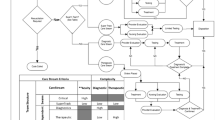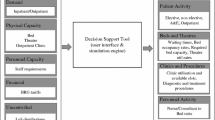Abstract
This paper presents a simulation model of the emergency department (ED) at a major UK hospital, which like most other EDs, is struggling to meet the key ED performance target to admit or discharge 95% of patients within 4 h of arrival. Only marginal improvements have been evidenced from recent investigations piloted as attempts to improve cost, quality and throughput in the ED, leading to increased enthusiasm from management to explore the potential of simulation to expedite patient flow. The objective of this project was to create a discrete event simulation model of the ED to improve understanding of the current system, identify shortcomings of previously piloted interventions and assess the impact of alternative initiatives. The project has served as an excellent means to promote simulation as an effective tool to design ED services. Its success to generate outputs above those anticipated by management has accelerated the development of a multidisciplinary Flow Team, which meets regularly at the hospital to review improvements and explore further proposals to improve patient flow.





Similar content being viewed by others
Explore related subjects
Discover the latest articles, news and stories from top researchers in related subjects.References
Ahmed M and Alkhamis T (2009). Simulation optimization for an emergency department healthcare unit in Kuwait. European Journal of Operational Research 198: 936–942.
Aneurin Bevan Health Board (2012). Aneurin Bevan Continuous Improvement: Creating a Health Board Centre for quality improvement, Technical report.
Ashton R, Hague L, Brandreth M, Worthington D and Cropper S (2005). A simulation-based study of a NHS walk-in centre. Journal of the Operational Research Society 56(2): 153–161.
Azadeh A, Shirkouhi N and Rezaie K (2010). A robust decision-making methodology for evaluation and selection of simulation software package. The International Journal of Advanced Manufacturing Technology 47: 381–393.
Baboolal K, Griffiths J, Knight V, Nelson A, Voake C and Williams J (2012). How efficient can an emergency unit be? A perfect world model. Emergency Medicine Journal 29: 972–977.
Banks J, Aviles E, McLaughlin J and Yuan R (1999). The simulator: New member of the simulation family. Interfaces 21(2): 76–86.
Bell D, McNaney N and Jones M (2006). Improving health care through redesign. British Medical Journal 332: 1286–1287.
Bernstein S, Aronsky D, Duseja R, Epstein S and Handel D et al (2008). The effect of emergency department crowding on clinically oriented outcomes. Academic Emergency Medicine 16: 1–10.
Bowers J, Ghattas M and Mould G (2009). Success and failure in the simulation of an accident and emergency department. Journal of Simulation 3: 171–178.
Brailsford S (2005). Overcoming the barriers to implementation of operations research simulation models in healthcare. Clinical Investigative Medicine 28: 312–315.
Cooke M and Jinks S (1999). Does the Manchester triage system detect the critically ill?. Journal of Accident & Emergency Medicine 16: 179–181.
Cooke M, Wilson S and Pearson D (2002). The effect of a separate stream for minor injuries on accident and emergency department waiting times. Journal of Emergency Medicine 19: 28–30.
Counselman F, Graffeo C and Hill J (2000). Patient satisfaction with physician assistants in an ED fast track. Journal of Emergency Medicine 18: 661–665.
Day T, Al-Roubaie A and Goldlust E (2013). Decreased length of stay after addition of healthcare provider in emergency department triage: A comparison between computer-simulated and real-world interventions. Journal of Emergency Medicine 30: 134–138.
Derlet R and Richards J (2000). Overcrowding in the nations emergency departments: Complex causes and disturbing effects. Annals of Emergency Medicine 35: 63–68.
Diefenbach M and Kozan E (2011). Effects of bed configurations at a hospital emergency department. Journal of Simulation 5: 44–57.
Duguay C and Chetouane F (2007). Modeling and improving emergency department systems using discrete event simulation. Simulation 83(4): 311–320.
Eitel D, Rudkin S, Malvehy M, Killeen J and Pines J (2010). Improving service quality by understanding emergency department flow: A white paper and position statement prepared for the American Academy of Emergency Medicine. Journal of Emergency Medicine 38(1): 70–79.
Fone D, Hollinghurst S, Temple M, Round A and Lester N (2004). Systematic review of the use and value of computer simulation modelling in population health and health care delivery. Journal of Public Health Medicine 25(4): 325–335.
Gunal M and Pidd M (2010). Discrete event simulation for performance modelling in health care: A review of the literature. Journal of Simulation 4: 42–51.
Health Foundation (2013). Improving patient flow: Learning report. Technical report.
Kelly A, Bryant M, Cox L and Jolley D (2007). Improving emergency department effciency by patient streaming to outcomes-based teams. Australian Health Review 31(1): 16–21.
Komashie A and Mousavi A (2005). Modeling emergency departments using discrete event simulation techniques. In: Proceedings of the 2005 Winter Simulation Conference. pp. 2681–2685.
Magid D, Sullivan A, Cleary P, Rao S and Gordon, JA et al (2009). The safety of emergency care systems: Results of a survey of clinicians in 65 US emergency departments. Annals of Emergency Medicine 53: 715–723.
Mizen P, Edwards L, Saleem H, Murray D and Norman A (2013). Medical CDU project. Technical report.
NHS Confederation (2012). Papering over the cracks: the impact of social care funding on the NHS. Briefing no. 248.
NHS England (2014) A&E Waiting Times and Activity. http://www.england.nhs.uk/statistics/statistical-work-areas/ae-waiting-times-and-activity/, accessed 29th June 2014.
O’Cathain A, Knowles E, Turner J, Hirst E, Goodacre S and Nicholl J (2016). Variation in avoidable emergency admissions: Multiple case studies of emergency and urgent care systems. Journal of Health Services Research and Policy 21(1): 5–14.
Paul S, Reddy M and DeFlitch C (2010). A systematic review of simulation studies investigating emergency department overcrowding. Simulation 86(8-9): 559–571.
Peck J (2009). Improving patient flow through axiomatic design of hospital emergency departments. In: Proceedings of the 19th CIRP Design Conference - Competitive Design. pp. 451–455.
Roche K and Cochran J (2007). Improving patient safety by maximizing fast-track benefts in the emergency department: A queuing network approach. In: Proceedings of the 2007 Industrial Engineering Research Conference. pp. 619–624.
Rondeau K and Francescutti L (2005). Emergency department overcrowding: The impact of resource scarcity on physician job satisfaction. Journal of Healthcare Management 50: 327–340.
Saghafian S, Austin G and Traub S (2014). Operations Research Contributions to Emergency Department Patient Flow Optimization: Review and Research Prospects. Working Paper. http://ssrn.com/abstract=2420163, accessed 22 May 2014.
Saghafian S, Hopp W, Van Oyen M, Desmond J and Kronick S (2012). Patient streaming as a mechanism for improving responsiveness in emergency departments. Operations Research 60(5): 1080–1097.
Sahu S, Baffour B, Harper P, Minty J and Sarran C (2014). A heirarchical Bayesian model for improving short-term forecasting of hospital demand by including meteorological information. Journal of the Royal Statistical Society: Series A (Statistics in Society) 177(1): 36–61.
Samaha S, Arnel W and Starks D (2003). The use of simulation to reduce the length of stay in an emergency department. In: Proceedings of the 2003 Winter Simulation Conference 2: 1907–1911.
Sargent R (2013). Verification and validation of simulation models. Journal of Simulation 7: 12–24.
Sinreich D and Marmor Y (2005). Emergency department operations: The basis for developing a simulation tool. IIE Transactions 37(3): 233–245.
Snooks H, Hartley-Sharpe C, Dale J and Halter M (2004). On-scene alternatives for emergency ambulance crews attending patients who do not need to travel to the accident and emergency department: A review of the literature. Emergency Medicine Journal 21: 212–215.
Snooks H, Kingston M, Anthony R and Russell I (2013). New models of emergency prehospital care that avoid unnecessary conveyance to emergency department: Translation of research evidence into practice? The Scientific World Jounral 2013: 182102. doi:10.1155/2013/182102.
Snooks H, Williams S, Crouch R, Foster T, Hartley-Sharpe C and Dale J (2002). NHS emergency response to 999 calls: Alternatives for cases that are neither life threatening nor serious. British Medical Journal 325: 330–333.
StatsWales (2014). Performance Against 4 hour Waiting Times Target by Major Hospital. https://statswales.wales.gov.uk/Catalogue/Health-and-Social-Care/NHS-Hospital-Waiting-Times/Accident-and-Emergency/PerformanceAgainst4HourWaitingTimesTarget-by-MajorHospital, accessed 29th June 2014.
Van Woerden H, Monaghan S, Huws D and Atenstaedt R (2013). Reducing demand for acute healthcare services. Public Health Wales, Technical report.
Wang X (2013). Emergency department staffng: A separated continuous linear programming approach. Mathematical Problems in Engineering. Article ID 680152.
Welch S (2009). Patient segmentation: Redesigning flow. Emergency Medicine News 31(8).
White K (2010). A survey of data resources for simulating patient flows in healthcare delivery systems. In: Proceedings of the 2005 Winter Simulation Conference. pp. 926–935.
Wiler J, Gentle C, Halfpenny J, Heins A and Mehrotra A et al (2010). Optimizing emergency department front-end operations. Annals of Emergency Medicine 55: 142–160.
Williams M (2006). Hospitals and Clinical Facilities, Processes and Design for Patient Flow, in Patient Flow: Reducing Delay in Healthcare Delivery, Stringer, New York.
Author information
Authors and Affiliations
Corresponding author
Appendix A: List of software
Appendix A: List of software
-
SIMUL8 A simulation tool that allows the user to create a virtual model of any department that processes discrete entities at discrete times. Basic features of the model can be built via a simple graphical interface and more advanced features can be added using SIMUL8’s own simulation language, Visual Logic. It’s design allows communication with other software packages, so parameters and results can be simply imported/exported. Popular alternatives to SIMUL8 include AnyLogic, Witness, Simio, ARENA, ProModel, Flexsim and Scenario Generator (for strategic planning for health and social care). Further guidance on selecting the most appropriate package is provided in Azadeh et al (2010).
-
R Open-source data analysis software in which the analysis is performed via scripts and functions written in the R programming language. Not only can the software be downloaded for free, but the source code required to perform the data analysis can be recycled from other projects and directly modified by the user. In this study, R was used for distribution fitting but it can also be used for general statistical analysis, data visualisation and predictive modelling. Alternative proprietary software include SAS, IBM SPSS and Stata.
-
Microsoft Excel Excel is widely available within many organisations and most NHS staff have a basic understanding of the software. Excel does contain a limited number of add-ins that can be used to perform data analysis, but its functionality remains very basic in comparison to the packages listed above.
Rights and permissions
About this article
Cite this article
Vile, J.L., Allkins, E., Frankish, J. et al. Modelling patient flow in an emergency department to better understand demand management strategies. J Simulation 11, 115–127 (2017). https://doi.org/10.1057/s41273-016-0004-2
Received:
Accepted:
Published:
Issue Date:
DOI: https://doi.org/10.1057/s41273-016-0004-2




